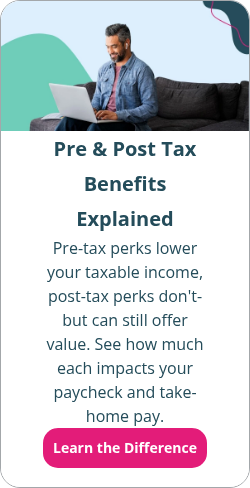Why your business should introduce an employee referral program
By Elizabeth Walker on January 16, 2024 at 3:48 PM
Hiring qualified candidates in today’s competitive labor market is challenging. Traditional recruiting methods can be successful, but weeding through hundreds of applicants to find the perfect candidate costs you valuable time and money. One way to refine your search for the perfect candidate is with an employee referral program.
Employer referral programs are a targeted and proactive way to source talented workers. Many employers believe hiring through referrals generates the greatest return on investment compared to alternate methods, like posting on job boards. Referred workers also tend to have lower employee turnover rates. But how can you start a referral program?
In this article, we’ll tell you everything you need to know about employee referral programs, including their advantages and how you can create one at your organization.
Takeaways from this blog post:
- An employee referral program encourages current employees to refer qualified candidates for open job positions by tapping into their professional networks.
- Referral programs can save businesses time and money by enabling employers to fill open positions faster and reduce recruitment expenses. Hiring through referrals also improves employee retention rates, with referred workers staying at the company longer.
- To create an effective employee referral program, it’s important to gather input from leadership, communicate with employees about program rules and incentives, track metrics, and make improvements when necessary.
What is an employee referral program?
An employee referral program is a recruiting technique where employers encourage their current employees to refer quality candidates to open job posts. The candidates are typically individuals the current employee knows personally, like previous coworkers, friends, or even family members. These programs often incentivize employees to make referrals.
Unlike other recruiting methods, referral programs source talented employees through an internal method. The goal is to have your existing workers recommend other top-performing workers in their network to target a more reliable talent pool. Due to their efficiency, experts believe referral programs are among the most effective recruiting strategies available1.
How do employee referral programs work?
Every company structures its employee referral program differently. But generally, each successful program works by announcing open positions to employees and offering effective incentives to those who refer a candidate the hiring manager then employs.
The incentive you use to motivate your employees to make referrals can vary. More than 70% of companies provide employee referral bonuses ranging from $1,000 to $5,000 per candidate hired2. If you’re on a tight budget, you can offer non-monetary rewards like extra paid time off (PTO), donations toward the employee’s favorite charity, gift cards, recognition, company swag, and more.
Often, the newly hired candidate must remain at the company for a certain period of time before the employee who made the referral receives their reward.
Why should businesses have an employee referral program?
These days, competing for talented workers is harder than ever. So, you’ll want to use every trick in the book to find the best job candidates. Employee referral programs shouldn’t be the only hiring process technique you use, but leveraging your employees to help you attract talented candidates has many advantages that can get you results.
Let’s look at four benefits of referral programs in the sections below.
They showcase your company’s brand
According to a recent survey, 75% of job seekers research a company's reputation before applying3. With referral programs, high-quality candidates learn about your company’s brand, culture, and reputation directly from the source—your employees.
When your current employees act as brand ambassadors, it highlights your company as a place where people want to work. In most cases, company employees refer friends or other professionals they know, so these candidates are much more likely to trust their opinions and apply to your job opening.
In addition to improving your brand status, hiring a referred candidate is a great way to improve employee morale and trust among your workforce. When your staff has a sense of ownership in your recruitment process, they’ll likely remain engaged at work.
They save you time and money
You can fill your open position faster through quality referrals. Employers typically push referrals to the front of the candidate pool due to their relationship with your current employee. This means you’re spending less time posting jobs and sourcing more applicants. On average, it takes 29 days to hire a referred candidate, compared to other hiring methods that take about 55 days4.
Referral programs often come with employee incentives, so you may think they’re more expensive than traditional hiring techniques. But, since referrals take less time to hire, the hiring costs are also lower.
According to SHRM5, the average cost to hire per employee is about $4,700. This number can be higher depending on how much you use job boards, ads, sourcing, pre-employment tests, background checks, or staffing agencies. With referral programs, employers save about $3,000 in recruiting costs per hire6.
They introduce you to highly qualified candidates
You likely believe you have qualified employees—that’s why you hired them. Luckily, employees tend to refer candidates who are team players with similar qualities to them. And because your current employees are already familiar with your company culture and values, they’re the perfect first step to determine if someone would be a good fit for an open position.
A referral is your employee’s stamp of approval of a person’s qualifications and abilities. According to Indeed, 74% of employers who hired referral candidates said the candidates were “extremely qualified” for the positions7. Another study8 found that employers are four times more likely to hire referred workers than non-referred employees.
But not all referrals are alike. Referrals can be significantly better when the referrer and candidate know each other well. So, if you have an open position that requires specific skills, tapping into your employees’ professional networks and gauging how well they know the referral candidate may be the fastest and most effective way to fill it.
They increase overall retention
The more qualified a candidate, the more likely they are to stay at your company long-term. And because employees hired through referrals are already strong matches due to their knowledge of your company and potentially similar qualities of a current employee, their retention rates are even higher.
While referrals only account for 7% of all job applicants, referred employees make up 40% of new hires9. According to Jobvite, once employed, 46% remain at the company longer than one year, 45% stay for more than two years, and 47% stay for more than three years.
Additionally, employees who make a successful referral tend to have lower turnover. Contributing to the company by bringing in new talent makes employees feel more accomplished, satisfied, and engaged. Employers can reduce their turnover rate by 20% between these two groups with an effective referral program2.
How you can create an employee referral program at your organization
Before implementing an employee referral program at your organization, you’ll need to know what actions to take to create and manage one. Below are four initial steps you should consider when designing your referral program.
Step 1: Get leadership buy-in
Like any new employee program, you need leadership buy-in if you want it to be successful. Start by showing them the program's value, how it will improve hiring and retention efforts, and how you want to motivate employees to make referrals. Management buy-in is also essential when determining your program’s budget for operation costs and incentives.
You and your other business leaders should also outline the goals of the referral program. Even though the overarching goal may be to recruit more people, there are smaller metric goals you may want to meet as well, such as reducing overall applicant-to-hire time or increasing your employee retention rate by a certain percentage each quarter.
Getting your leaders’ feedback on these goals will make your program more structured, inclusive, and sustainable.
Step 2: Determine your referral system
A key component of your referral program is having a system in place to ensure it runs smoothly. You won’t impress your referred candidates by not following up with them, nor will you keep your current employees engaged in the program if communication is poor or your incentives are lacking.
Design your program to be easy to understand. Ensure employees know how to make referrals and keep the process simple so it doesn’t seem like a chore for them to participate in. For example, you can send a company-wide email whenever a new open position is available with an attachment reminding employees of the referral program rules.
Manually running your referral program can lead to mistakes. So, see if your budget allows you to invest in employee referral program software. These programs can simplify the referral process for your employees, talent acquisition teams, and potential candidates.
Step 3: Educate your employees
As an employee-based program, good communication is vital to its success. Once you design your program, teach your employees how it works, including how they can submit referrals and the incentives they’re eligible to receive. Ensure your job descriptions are clear so your employees know the type of person you’re looking for and can make good recommendations.
Lastly, make the program rules widely available if employees need a refresher, such as in your company newsletter, town halls, or onboarding process. Your HR team should also be available to answer your employees' questions.
Another great way to hype your program is by celebrating an employee who refers a successful hire. For example, you can spotlight them in team meetings, on your social media pages or messaging platforms, or even your company’s website. Public recognition is a great way to reward employees for their contributions and motivate others to submit future referrals.
Step 4: Track the success of your program
After your program launch, you must monitor it to ensure it meets your goals and determine if changes are necessary. Review your goals regularly to guarantee you’re still on track, ensure your process results in quality candidates, and refresh your incentives periodically to keep employees engaged.
You may want to revise your referral program if you experience any of the following changes:
- A drop in referrals or the number of hired referrals
- A lower retention rate of referred employees
- You introduce a new or additional referral bonus
- Reduced employee engagement in the program
- A change in your company’s structure, such as an overhaul of your HR or recruiting teams
- A change in your work environment, such as switching from in-office to hybrid or fully remote
- An update of your organizational goals
- An increase or reduction of your company’s budget for recruiting
- An update of your referral program’s metrics
Refining your program as you go along based on results and feedback is more likely to ensure its success.
Conclusion
As an employer, your employees are your biggest asset. So why not entrust your employees with helping you find more talented individuals who can help your business succeed? Employee referral programs streamline your hiring process, take pressure off your recruiting and HR teams, and turn your staff into brand ambassadors.
Creating a successful employee referral program isn’t a “one-and-done” task. It’s vital to revisit your referral program periodically to assess its effectiveness, update your goals, and ensure your recruitment strategy meets your organization’s needs so you’re hiring the best people available.
1. https://www.linkedin.com/pulse/rethinking-employee-referral-programs-nasser-oudjidane/
2. https://www.zippia.com/advice/employee-referral-statistics/
3. https://www.linkedin.com/pulse/how-rethink-using-linkedin-your-job-search-gerry-moran/
5. https://www.shrm.org/topics-tools/news/talent-acquisition/real-costs-recruitment
7. https://www.indeed.com/hire/c/info/5-ways-to-create-an-effective-employee-referral-program
8. https://goremotely.net/blog/employee-referral-statistics/
9. https://www.frontify.com/en/blog/how-to-communicate-culture-internal-and-employer-branding/
Check out more resources
See these related articles

What is the employee life cycle?
Understanding the employee life cycle is crucial for HR teams. Dive into this guide to gain insights on each stage and optimize your management strategies.

Seven steps to take when offboarding employees
Offboarding employees can be a complex process. But with these seven steps, you can ensure a smooth transition for both the employee and your organization.

Top recruiting strategies for your veterinary clinic
Finding the right talent for your veterinary clinic can be challenging, but with a recruiting strategy, you can attract and retain your employees.



